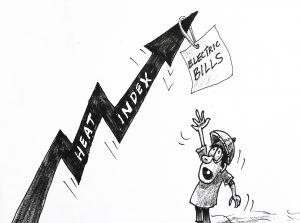At this time of the year when temperatures are soaring high, air conditioners, fans, and refrigerators have become essential for surviving the sweltering heat, especially in regions where temperatures can soar to dangerous levels. This dependence, while necessary, leads to an inevitable spike in electricity consumption, resulting in electric bills that strain already tight budgets.
The need for cooling appliances is a matter of survival, not luxury. Heatwaves have become more frequent and intense due to climate change, making it almost impossible to endure without some form of artificial cooling. For vulnerable populations, such as the elderly and children, prolonged exposure to extreme heat can lead to severe health issues or even fatalities. Consequently, households have no choice but to run air conditioners and fans almost continuously during the hottest months. This relentless use of electricity pushes consumption to unprecedented levels, inevitably leading to higher utility bills.
These increased electric bills pose a significant financial burden for many families, particularly those with limited incomes. The cost of running air conditioners and other cooling devices adds up quickly, depleting funds that could be used for other essential needs like groceries, medical expenses, or education. For low-income households, the choice often becomes one of stark trade-offs: endure unbearable heat or cut back on other necessities to pay for the increased electricity usage. This dilemma highlights a harsh reality wherein maintaining a basic standard of living in the face of extreme weather becomes a matter of economic survival.
Furthermore, the escalating cost of electricity is compounded by the inefficiencies of older cooling appliances. Many households cannot afford to upgrade to energy-efficient models, which, although more cost-effective in the long run, require a significant upfront investment. As a result, they continue to use outdated units that consume more power, further exacerbating the problem. This creates a vicious cycle where high energy consumption leads to high bills, leaving little room in the budget for purchasing more efficient appliances that could alleviate some of the financial strain.
In response to this pressing issue, governments and utility companies must step in with solutions. Subsidies for energy-efficient appliances, incentives for households to adopt solar energy, and tiered billing systems that provide relief to lower-income families can help mitigate the financial impact. Additionally, investing in community cooling centers and urban greening initiatives can reduce the overall demand for home cooling. Addressing the root causes of climate change through stringent environmental policies is equally vital to ensuring long-term sustainability and reducing the need for excessive energy consumption.
Indeed, the high consumption of electricity driven by the necessity to cool homes in extreme heat is an unavoidable reality for many households. The resulting financial strain from massive electric bills highlights the need for systemic interventions to support those most affected. By promoting energy efficiency, providing financial assistance, and tackling climate change, we can help households manage their electricity consumption and alleviate the economic burden that threatens their well-being.




